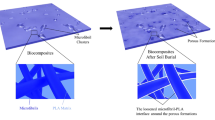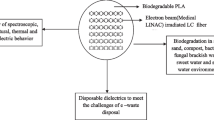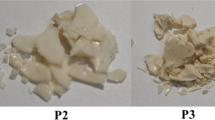Electrospun non-woven polylactide and poly(3-hydroxybutyrate) fibers are promising ecologically benign materials. Their fiber structures were studied using IR spectroscopy, optical microscopy, and differential scanning calorimetry. An evaluation of damage to the polymer samples by various micromycetes found that poly(3-hydroxybutyrate) was damaged more by mold fungi such as Aspergillus niger and Penicillium purpurogenum and a mixed fungal culture. Soil biodegradation tests showed that this material was degraded more than polylactide after incubation for 60 d. This was confirmed by the change of its thermophysical characteristics.
Similar content being viewed by others
Explore related subjects
Discover the latest articles, news and stories from top researchers in related subjects.Avoid common mistakes on your manuscript.
Polymers have found applications in all industrial sectors from the food industry to rocket manufacturing [1,2,3]. As a rule, construction plastics, e.g., polycarbonates and carbon plastics, should have long service lives; others such as food packaging, air filters, and medical instruments that are increasingly often being produced from biodegradable polymers should have short lives [4,5,6]. Polylactide (PLA), polycaprolactone, and poly(3-hydroxybutyrate) (PHB) are such polymers whose structures and properties have been studied for less than a decade [7,8,9].
PHB is a linear polyhydroxyalkanoate polyester. It is extracted from bacterial biomass of a particular strain that is cultivated on carbohydrate growth medium [10].
Biodegradable PLA is produced in two steps, i.e, lactic-acid fermentation of wort followed by polymerization.
Wastes from beet, corn, and grain production are the raw materials for both polymers. This is a definite advantage over polymers produced from oil [11, 12]. A part of the polymeric wastes from used raw material enters the environment and often has negative impacts on plants, animals, aquifers, and soil. Degradation of the polymer at various temperatures must be studied at elevated humidity and in different soils, including possible destruction by mold fungi, to evaluate these effects [13, 14].
Fungal resistance and the ability of various microorganisms to degrade polymers have been studied for a long time [15,16,17]. It is noteworthy that many lower organisms can cause biodegradation. However, mold fungi take first place in effectiveness and number of species. This issue is still critical because of the emergence of novel synthetic organic strategies and new polymer fibers and films.
The goal of the present work was to study the possibility of using mold fungi to degrade non-woven fibrous materials made of natural polymers, i.e., PHB and PLA.
Degradation by soil micromycetes was studied using non-woven fibrous polylactide (PLAf) and poly(3- hydroxybutyrate) (PHBf). Films of the synthetic polymers low-density polyethylene (LDPE) and poly(3-hydroxybutyrate) (PHB) were studied for comparison.
The fibrous materials were produced using a modern electrospinning method [18,19,20]. Electrospinning is a process involving the hydrodynamics of weakly conducting liquids and phase transitions, i.e., evaporation of solvent and efflux of the polymer fiber. The high potential induces identical electrical charges in the polymer solution that cause it to stretch into a thin jet because of Coulombic electrostatic interactions. Electrostatic drawing can cause the polymer jet to split into thinner jets at a certain ratio of viscosity, surface tension, and electrical charge density (or electrostatic field potential). The outflowing jets harden because of solvent evaporation or cooling and transform into fibers. Electrostatic forces deposit them on a grounded substrate with the opposite electrical potential. The diameters of the obtained fibers can be micro- and nanometers [21,22,23].
PLA (4032D grade, Nature Works, USA) of molecular mass 1.9·105 Da and density 1.24 g/cm3; finely disperse PHB powder (Biomer, Germany) of molecular mass 2.3·105 and density 1.25; and LDPE (15803-020 grade, Russia) of density 0.92 were used to produce the fibrous materials. Solutions of PLA and PHB in CHCl3 were used to electrospin fibrous materials on an EFV-1 system (Russia). The potential on the electrodes was 17-18 kV; distance from the upper electrode to lower one, 18 cm. Films were produced on a PRG-10 hydraulic press with electronics for heating the plate followed by cooling in air. Seven samples were used in all experiments.
Thermophysical characteristics were determined on a Netzsch DCS 204 F1 instrument (Germany). The scan rate was 8°C/min. Sample masses varied in the range 5-6 mg. Indium (mp 156.6°C) was used for calibration. The measured melting points were accurate to ±0.1°C. The degree of crystallinity (χcr, %) was calculated using the formula:
The fiber structure of non-woven material was studied on an Olympus CX43 optical microscope (Japan) in transmitted light at magnifications 4, 10, and 20×.
The orientation of the polymer chains was evaluated using IR spectroscopy on a Bruker IFS-48 spectrophotometer (USA) in transmission mode. Optical density of bands was measured parallel (D||) and perpendicular (D) to the sample position. The orientation factor, i.e., dichroic ratio (R), was calculated for the structural band of continuous chains (amorphous phase) at 1182 cm–1.
Soil tests in reconstituted ground used samples prepared according to GOST 9.060–75. Polymer samples were placed into soil at 22 ± 3°C in which humidity was maintained at 60-65% using regular watering and measured using an ETR-301 special feeler gauge (Russia). Results were evaluated after biodegradation for 60 d.
Fungal resistance tests used methods 1 and 3 of GOST 9.049–91. According to method 1, polymers were inoculated with drops of an aqueous suspension of mycelial fungal conidia. According to method 3, liquid Czapek Dox medium with sucrose was sprayed with the suspension from a bottle. The materials were incubated in moist and warm air. Growth and development of fungi in samples were visually assessed on a scale from 0 to 5 balls. The microbiological studies used samples as strips (10 × 1 cm) that were cleaned and sterilized with EtOH and then dried in Petri dishes.
Structural parameters were studied in detail using IR spectroscopy and differential scanning calorimetry (DSC). Intercrystallite regions in non-woven PHB materials with different polymer contents (5, 7, and 9%) in the spinning solution were studied using IR spectroscopy. The results (Fig. 1) showed that the degree of anisotropy of PHB macromolecules in the intercrystallite regions decreased with increasing polymer concentration in the spinning solution. Apparently, crystallization was accelerated as the polymer concentration in the spinning solution increased. The amorphous intercrystallite regions of the polymer were compacted, which prevented sections of the macromolecules from orienting primarily along the direction of the electrostatic forces during drawing of the spinning-solution primary jet.
DSC determined that the melting point was practically constant whereas the degree of crystallinity increased by 2-3% as the PHB solution concentration increased [2].
Non-woven fibrous materials produced from 7% PHB and PLA solutions were used in further experiments because the viscosities of these solutions and the distributions of the resulting materials on the substrate were optimal. The sample thicknesses were 35-40 μm.
Figure 2 shows melting thermograms of PHB (a) and PLA fibrous materials (b). Peaks are clearly visible for fusion and destruction.
The nonequilibrium structure of the polymer fiber affected the chemical resistance of the material by determining its capability for biodegradation in various aggressive media, not only because of the nature of the polymer but also structural features of the polymer matrix.
Images of PLA and PHB fibrous materials before and after degradation in soil for 60 d were obtained using optical microscopy (Fig. 3). PHB fibrous material (Fig. 3d) was significantly more degraded in soil than PLA material although both polymers were natural linear polyesters. This phenomenon may have been related to the production method. PHB was produced via microbiological synthesis as a reserve compound. PLA was produced in two steps. Lactic acid was first obtained from plant raw material and then polymerized.
Apparently, PHB was easier to affect because of the greener method for producing it by microorganisms such as mold fungi and bacteria.
Melting points and degrees of crystallinity of the starting PLA and PHB non-woven materials before and after biodegradation in soil were determined using DSC to study the crystalline phase (Table 1).
The mp and χcr of PLA and PHB both decreased. However, these values dropped much more significantly for PHB. Although χcr decreased by 5% for PLA, it dropped by 12% for PHB. This was indicative of active biodegradation of this fibrous material.
Large populations of various micromycetes are known to develop in soil. The next experimental stage according
to the GOST was to use mold fungi, which are most active for polymers, and a mixed fungal culture.
Test results (Table 2) for method 1 indicated that non-woven fibrous PHB and PLA materials underwent microbiological degradation. Micromycetes of the genus Aspergillus and the mixed mold fungal culture were especially aggressive toward them. If growth medium was present (method 3), then practically all tested micromycetes degraded the PHB and PLA samples. However, PHB was more extensively biodegraded in soil. It is noteworthy that UV radiation, temperature, the aqueous solution, and mechanical damage affected the polymers under actual conditions and accelerated significantly the degradation of the polymer matrix.
References
S. Agarwal, A. Greiner, and J. H. Wendorff, Prog. Polym. Sci., 38, No. 6, 963 (2013).
F. G. Banica, Chemical Sensors. Biosensors, Fundamentals and Applications, Wiley, New York, 2012.
V. M. Shchetinin, I. V. Tikhonov, and A. V. Tokarev, Khim. Volokna, No. 6, 7-9 (2016).
X. Wang, Y.-G. Kim, et al., Nano Lett., 4, 331-334 (2004).
A. A. Ol2khov, Yu. V. Tertyshnaya, et al., Russ. J. Phys. Chem. B, 12, No. 2, 293-299 (2018).
M. Khil, D. Cha, et al., Biomaterials, 67, 675-679 (2003).
Yu. V. Tertyshnaya and M. V. Podzorova, Russ. J. Appl. Chem., 91, No. 3, 417-423 (2018).
Yu. V. Tertyshnaya, L. S. Shibryaeva, and A. A. Ol2khov, Russ. J. Phys. Chem. B, 9, No. 3, 498-450 (2015).
El-Hadi, R. Schnabel, et al., Polym. Test., 21, 665-674 (2002).
F. Ravenelle and R. Marchessault, Biomacromolecules, 4, 856 (2003).
G. A. Bonartseva, V. L. Myshkina, et al., “Method of preparing poly-β-hydroxybutyrate of required molecular mass,” RU Pat. 2,201,453, Oct. 18, 2001.
L.-T. Lim, R. Auras, and M. Rubino, Prog. Polym. Sci., 33, 820-852 (2008).
Yu. V. Tertyshnaya and L. S. Shibryaeva, Usp. Med. Mikol., 12, 145-147 (2014).
M. V. Podzorova, Yu. V. Tertyshnaya, et al., “Biodegradation of polyethylene-polyhydroxybutyrate polymer composites by soil micromycetes,” in: Modern Mycology in Russia. Proceedings of the IIIrd International Ecological Forum [in Russian], 2015, pp. 294-297.
A. A. Malama, V. N. Nesterenko, et al., Mikol. Fitopatol., 16, No. 6, 509-514 (1982).
Yu. V. Tertyshnaya, P. V. Pantyukhov, et al., Plast. Massy, No. 5, 61-63 (2012).
O. V. Sychugova, N. N. Kolesnikova, et al., Plast. Massy, No. 9, 29-33 (2004).
Y. Filatov, A. Budyka, and V. Kirichenko, Electrospinning of Micro- and Nanofibers: Fundamentals in Separation and Filtration Processes, Begell House Inc., New York, 2007, p. 404.
A. Zyabitskii, Theoretical Bases of Fiber Spinning, Khimiya, Moscow, 1979, 503 pp [translated from English by O. K. Perepelkina and K. E. Perepelkin].
D. H. Reneker, A. Yarin, et al., in: Advances in Applied Mechanics, Vol. 41, H. Aref and E. van der Giessen (eds.), Academic Press, 2007, pp. 43-195.
A. A. Ol2khov, V. S. Akatov, et al., Khim. Volokna, No. 3, 90-95 (2017).
Yu. V. Tertyshnaya, N. S. Levina, et al., Khim. Volokna, No. 2, 41-44 (2019).
X. Zong, K. Kim, et al., Polymer, 43, 4403-4412 (2002).
M. A. Abdelwahab, A. Flynn, et al., Polym. Degrad. Stab., 97, 1822-1828 (2012).
Yu. V. Tertyshnaya and L. S. Shibryaeva, Vysokomol. Soedin., Ser. A, 55, No. 3, 363 (2013).
The results in the article were obtained during work on State Task No. 1201253305 on topic 44.3 “Polymer materials science: Quantitative bases of chemical and physical processes in polymers, composites (including nanocomposites), and model systems” (IBCP RAS). The work used instruments at the New Materials and Technology Common Use Center (IBCP RAS).
Author information
Authors and Affiliations
Corresponding author
Additional information
Translated from Khimicheskie Volokna, No. 1, pp. 40-44, January—February, 2020.
Rights and permissions
About this article
Cite this article
Tertyshnaya, Y.V., Shibryaeva, L.S. & Levina, N.S. Biodestruction of Polylactide and Poly(3-Hydroxybutyrate) Non-Woven Materials by Micromycetes. Fibre Chem 52, 43–47 (2020). https://doi.org/10.1007/s10692-020-10148-z
Published:
Issue Date:
DOI: https://doi.org/10.1007/s10692-020-10148-z







